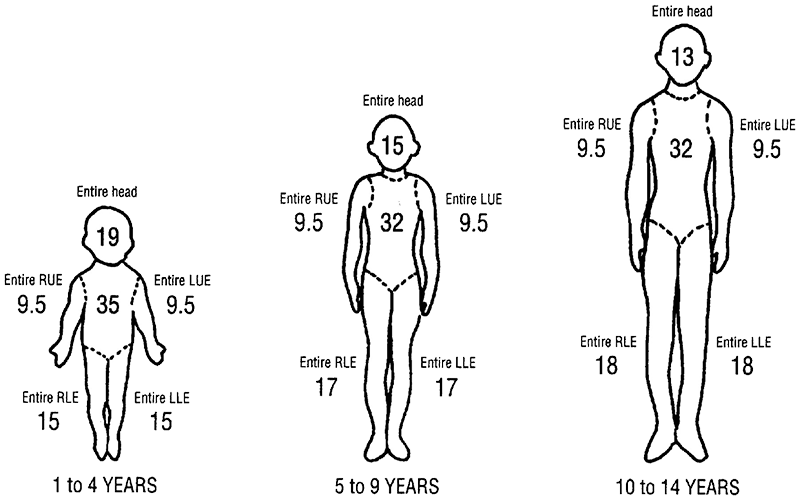Weight Dependent Drip Calculations
Published (updated: ).

So what if the Doctor orders you to administer an amount of fluid per hour based on weight? This is not uncommon in pediatrics where aggressive fluid therapy can easily save a child’s’ life; the difference between hydration and fluid overload may be something in the neighborhood of 100cc. Consider the following order:
ORDERED: Administer 10cc/kg over 3 hours. Patient weighs 44 pounds
ON HAND: Normal Saline 1000cc bags, 15-drop administration set
ADMINISTRATION: First, convert pounds to kilograms: 44lbs / 2.2lbs per kg = 20kg. Next, figure out how many cc’s to give: 10cc * 20kg = 200 cc
Next, figure out how many cc’s to give per hour: 200cc / 3hrs = 66.66 cc/hr
Finally, figure out how many drops per minute to get you 66.66 cc/hr: (remember the formula: volume * drip set / time in minutes). 66.66 * 15 / 60 = 16.665 or 17 drops per minute

Let’s look at another weight dependant drip calculation. The Parkland Formula was developed at the famous Parkland Memorial hospital. Parkland is the community hospital in Dallas Texas where President John F. Kennedy was taken after he was shot on November 22, 1963. The Parkland Formula was developed at the hospital to be used as a guideline for fluid resuscitation within the first 24 hours (keep in mind that patients with critical burns often die of hypovolemic shock due to the loss of fluid). Below is a version of formula used today:
Fluids for 24 hours = (4 cc/ kg * %burn [area])with 1st 50% of that total in the first 8 hours and the 2nd 50% over the following 16 hours.
Let’s say that medical control has ordered you to begin fluid therapy for a critically burned patient while enroute to the hospital and ordered you to calculate the dose based on the Parkland Formula (it could happen, some ambulance services even have this in their protocols). To figure out how much fluid to administer, you will have to break it down by hour. Here goes:
Fluids for 24 hours = (4 x kg x %burn) with ½ given in the first 8 hours, the remaining 50% given over 16 hours.
First let’s figure out how many cc’s to administer over the entire 24 hours:
Lets say the patient weighs 165 pounds or 75kg and has sustained burns on 25% of his body (second and third degree burns combined). First we use the formula to figure out how many cc’s to give him over the entire 24-hour period:
4cc x 75kg x 25 (we multiply times the number of percent, not the actual percentage) = 7500cc/24 hours
Now figure out how many cc/hr to administer by dividing 7500 by 2. 7500 / 2 = 3750cc/the first 8 hours
You deliver 3750cc over the first 8 hours, then another 3750cc over the remaining 16 hours. Let’s calculate the drip rate over the first 8 hours:
3750cc / 8 hours = 468.75 or 469cc/hr
Remember that the drip rate formula is: volume * drip rate / time (minutes). Let’s use a 15-drop set:
469cc * 15 = 7035 drops administered per hour
7035 drops administered per hour / 60 minutes = 117.25 or 117 drops per minute

So for the first 8 hours, you will administer 117 drops per minute. Let’s look at the remaining 16 hours:
Let’s save some math and just pick up from where we left off. We know that after 8 hours, we will have administered half of our Parkland Formula amount, so we have to deliver the final half over 16 hours. To do this we administer the remaining 3750cc over 16 hours. To figure out how much per hour, we simply divide 3750 by 16:
3750cc / 16 hours = 234.375 or 234cc/hr
Now we just plug that number into our drip rate formula:
234 * 15 / 60 = 58.5 or 59 drops per minute (or you could have just divided the 8 hour drip rate in half)
